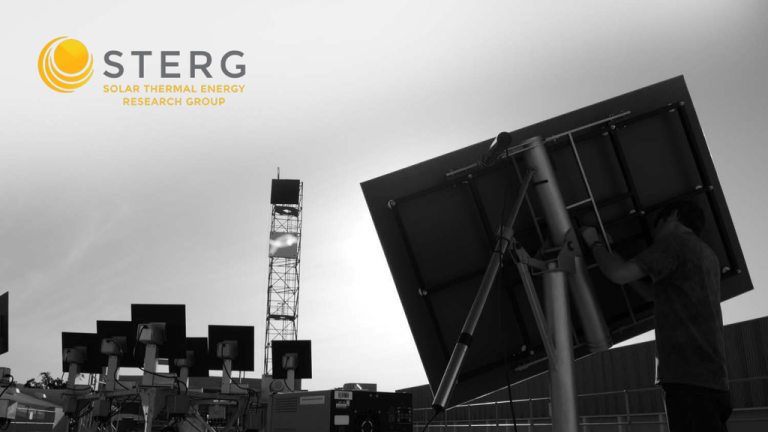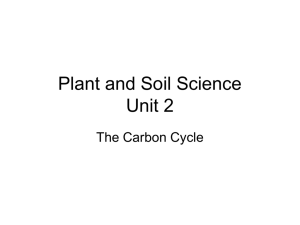1
advertisement

1 Development of a dual-pressure air receiver for the SUNDISC cycle: Initial findings on the HPAR concept L. Heller & J. Hoffmann aSolar Thermal Energy Research Group (STERG), Stellenbosch University, South Africa 2 Introduction Implementation Modeling and First Findings Outlook 3 The SUNDISC cycle • high cycle efficiency • low co-firing rates • ‘baseload’ characteristics • cost-effective rock-bed TESS • high capacity factor of pressurized receiver system 4 The HPAR concept • tubular metallic absorber – Tout,max ≈ 800 °C • ‘macro-volumetric’ effect • dual-cooling of absorber 5 Introduction Implementation Modeling and First Findings Outlook 6 Flow path SOLGATE receiver system (Buck, 2003) 7 Boundary conditions for HPAR system (5 MWe GT) • 𝑚𝑚̇ press. air • pin • Tin • Tout • 𝑄𝑄̇ press. air • Ttube,max • ∆pHPAR,max = 20.5 kg/s = 14.7 bar = 400 °C = 800 °C = 9 MWt = 950 °C = 100 mbar 8 Introduction Implementation Modeling and First Findings Outlook 9 Optics – Modeling Photo of Sierra SunTower (adapted from Schell, 2011) Visualization of hit points from HPAR ray tracing simulation 10 Optics – Findings ∆rn ∆φ • flux distribution greatly influenced by tube layout – – – – – φn,0 φm,0 angular offset φ0 distance ∆r / ∆φ receiver tilt wall design/properties (solar field/sun position!) flux penetration for differing angular offset between rows ‘2’ and ‘3’ 11 Thermal radiation – Modeling Assumptions: • infinitely long tubes • same T-profile per row • for radiation: tube has binary T-profile (front/back) More detailed thermal radiation model should be applied (see Section ‘Outlook’) 12 Flow in tubes – Modeling • Gnielinski correlation enhanced for circumferentially changing flux after Reynolds (1963) and Gärtner et al. (1974) • chosen: Di = 25 mm / Ltube = 2 m / nrows = 10 (in series) -> Umean = 15 m/s -> Remean = 40 000 -> 𝑚𝑚̇ max = 0.03 kg/s (per flow path/column) -> Numean = 83 / hmean = 30 W/(m2 K) 13 Flow in tubes – Findings • serial flow path leads to low flow velocity and heat transfer • 𝑄𝑄̇ Re = 1.11 MWt 14 Flow in tubes – Double flow path • partially parallel flow paths appears more favorable • however, larger temperature difference occur between tube and air for higher air velocity • 𝑄𝑄̇ Re = 3.49 MWt 15 Flow in tubes – Heat transfer enhancement (HTE) • temperature difference between absorber (front) and air can be lowered by increasing heat transfer through HTEs at the cost of higher friction factors • Chen et al. (2001) recommend dimples, Uhlig et al. (2015) tested corrugated tubes • 𝑄𝑄̇ Re = 4.13 MWt 16 Flow around tubes – Modeling • so far heat transfer modeled as flow around individual tubes only • more detailed (3-D) model will be build in CFD • For Umean,o = 4 m/s – Numean,o – ∆Tair,o = 20 = 35 °C • For Umean,o – Numean,o – ∆Tair,o = 0.4 m/s = 6.3 = 102 °C • wanted: ∆Tair,o > 400 °C 17 Flow around tubes – Findings • heat transfer in tube bundle too poor to heat up considerable amount of air to desired temperature • at lower velocities, wind will be problematic • more elaborate modeling necessary but not expected to change the heat transfer to the needed extend • external HTE or additional volumetric receivers at the inner wall are conceivable 18 Introduction Implementation Modeling and First Findings Outlook 19 • A CFD model will be created to conduct more detailed simulations of thermal radiation, heat transfer under circumferentially inconstant flux and heat transfer from the tube bundle to the unpressurized air stream • additionally to the basic layout, the following enhancements will be investigated: – external HTEs – quartz glass inserts for radiation distribution and flow improvement 20 ACKNOWLEDGEMENTS: CONTACT DETAILS: Lukas Heller Solar Thermal Energy Research Group (STERG) Stellenbosch University South Africa LukasHeller@sun.ac.za +27 (0)21 808 4016 visit us: concentrating.sun.ac.za 21 Buck, R., 2003. Modularer Druck-Receiver für solarunterstützte fossile Gasturbinen- und Kombikraftwerke (REFOS-2) Schlußbericht. Stuttgart. Chen, J., Müller-Steinhagen, H., Duffy, G.G., 2001. Heat transfer enhancement in dimpled tubes. Appl. Therm. Eng. 21, 535–547. doi:10.1016/S1359-4311(00)00067-3 Gärtner, D., Johannsen, K., Ramm, H., 1974. Turbulent heat transfer in a circular tube with circumferentially varying thermal boundary conditions. Int. J. Heat Mass Transf. 17, 1003– 1018. doi:10.1016/0017-9310(74)90182-3 Reynolds, W.C., 1963. Turbulent heat transfer in a circular tube with variable circumferential heat flux. Int. J. Heat Mass Transf. 6, 445–454. doi:10.1016/0017-9310(63)90119-4 Schell, S., 2011. Design and evaluation of esolar’s heliostat fields. Sol. Energy 85, 614– 619. doi:10.1016/j.solener.2010.01.008 Uhlig, R., Gobereit, B., Rheinländer, J., 2015. Advancing Tube Receiver Performance by Using Corrugated Tubes. Energy Procedia 69, 563–572. doi:10.1016/j.egypro.2015.03.065 22





